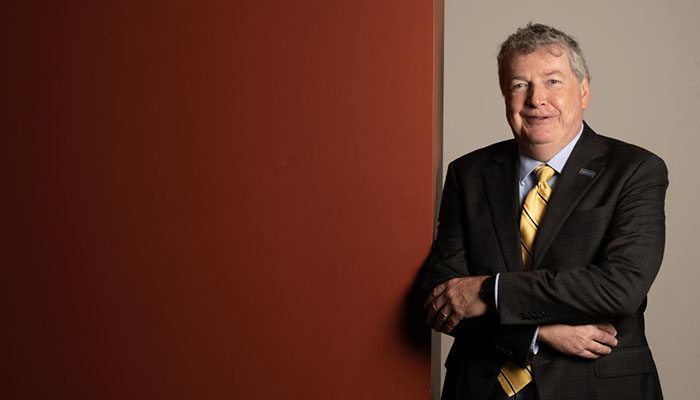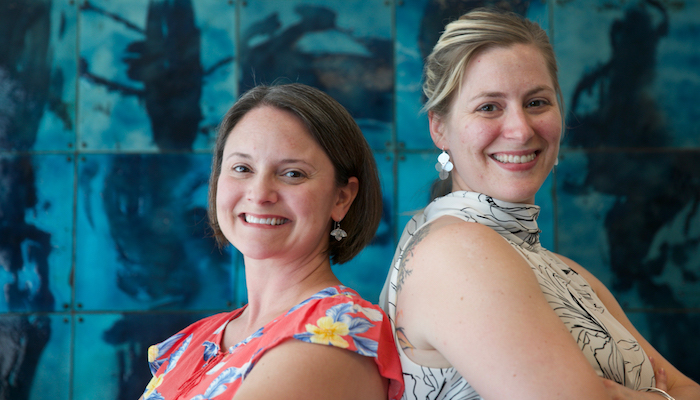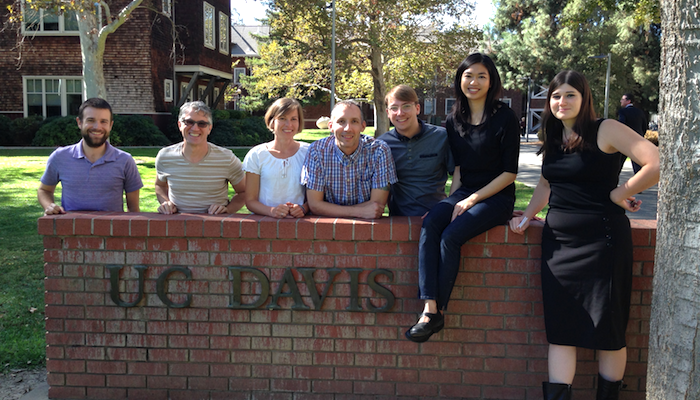Connecting the Future: How a UC Davis Invention Helped Build Broadband Communications
By Lisa Howard
Jonathan Heritage has never seen a manufactured version of the device he co-invented, although he once saw a prototype at Movaz Networks Inc., the first company to license the patent.
“It fit into one slot on an electronics rack, so it was as wide as that.” Heritage, a retired professor of engineering, held his hands about a foot and a half apart. “It was just a box. But inside, there were a whole lot of electronics, which were needed to drive all those mirrors,” said Heritage.
That nondescript box contained what the telecommunications industry refers to as a wavelength selective switch, known as WSS, a sophisticated device that uses tiny mirrors to route signals between fiber optic cables.
“You can find WSS where a lot of fibers come together for information flow, such as switching facilities in big cities,” said Heritage.

Professor Emeritus Jonathan Heritage at the UC Davis Office of Research, February 2019. Heritage retired from UC Davis in 2004. Earlier this year, Heritage was elected to the prestigious National Academy of Engineering. (Lisa Howard/UC Davis)
When Heritage and his co-inventors at UC Davis first conceived of WSS in the mid- to late-1990s, broadband was mostly just an idea, and the internet, or more specifically the World Wide Web, was in its infancy but growing rapidly.
In 1997, only 18 percent of U.S. households were using the internet, and Amazon, “the leading online retailer of books,” was only three years old. Google wouldn’t be founded until the following year, and AOL’s 10 million subscribers were mostly using dial-up connections through their telephone lines to get internet access.

In the 1990s, most households accessed the internet with dial-up modems, like this U.S. Robotics Sportster 14,400 fax modem from around 1994. (Wikipedia Creative Commons)
About that same time, telecommunications companies were beginning to build fiber optic networks that could carry significantly more data than the traditional copper wire used in the phone systems.
Fiber optic cables use a technology known as “wavelength division multiplexing,” which allows multiple data signals to be sent within a single fiber using different wavelengths of laser light.
Before joining the UC Davis faculty in 1991, Heritage worked at Bell Labs and also Bell Communications Research, known as Bellcore. He had a broad understanding of both the engineering challenges and the growing commercial needs of telecommunications companies.
“Fiber was becoming inexpensive and good enough quality that it made sense to build the networks,” said Heritage. “It can run long distances and it also supports a lot of bandwidth.”
But a major challenge was finding better methods for routing multiple channels into — and out of — fiber optic cables without blocking or interfering with any other channels.
“It was becoming evident that wherever fibers came together you’d have to have some sort of switch,” said Heritage.
The fiber optic cables were like a super speedy data highway without large enough connectors — the onramps and offramps. Because the amount of data being transmitted was increasing significantly, any new “onramps” and “offramps” would need to be able to be able to scale up in a big way.
In the mid-1990s, Heritage and his colleague, Olav Solgaard, an assistant professor in the UC Davis Department of Engineering, began talking about what a better device for routing multiple optical channels might look like.
“Jon got me interested,” said Solgaard. “We would talk about how we could use MEMS mirrors to do optical switching.”
Solgaard had worked on optical micro-electro mechanical systems, known as MEMS, when he was a post-doctoral fellow at UC Berkeley, and he also worked with fiber optics for his Ph.D. at Stanford. Solgaard noted that the idea of using MEMS mirrors to do optical switching — routing the signals — was already being pursued.
Essentially, light in the fiber optic cables could be routed using mirrors. “The ideas at that time involved mirrors for each fiber combination,” Solgaard explained. “So, for example, with 10 fibers in, and ten fibers out, you would need a hundred mirrors to shuffle the signals.”
That system worked. The problem, Solgaard said, came when you tried to scale it up. “With that model, for a thousand cables, you would need a thousand times a thousand mirrors — that’s a million mirrors.”
A Scalable Solution
The solution Solgaard came up with involved two micro-mirror arrays, instead of just one, that could separate the input optical beams by wavelength and then redirect the signals. In their version, a thousand cables would need 2,000 micro mirrors, not a million.

The “wavelength selective switch” used two micro-mirror arrays that could separate the input optical beams by wavelength and then redirect the signals. Their device became a critical component for data transmission in multi-wavelength fiber optic communication systems. (US Patent 6097859)
Heritage immediately recognized the commercial potential of the two-mirror device. “It was very evident to me that this was a good way to go.”
Amal Bhattarai, a graduate student in Heritage’s lab at the time, switched labs to join Solgaard for the optical switch project. “My background was in semiconductors and optics, which fit Professor Solgaard’s needs for a skilled grad student,” said Bhattarai.
With his understanding of the telecommunications industry, Heritage realized it would just be a matter of time before someone else came up with the idea. They would need to work quickly. “I told Solgaard, ‘We’ve got to stop talking about it. We’ve got to disclose.’”
The team dedicated themselves to refining the idea. Working in the optics lab in the basement of Kemper Hall, Bhattarai helped design and test a simple version of the switch. Within a few months they disclosed the invention to the University of California, the first step in the patent process. (As University of California employees, rights to their inventions are assigned to the university, which shares a percentage of any royalty income with the inventors.)
In February 1998, the University of California filed a patent application for the invention, listing Solgaard, Heritage and Bhattarai as the inventors.
Their first patent application was granted two years later in August of 2000: US6097859 “Multi-wavelength cross-connect optical switch.” It would be the first of a total of 9 patents involving their cross-connect switch for fiber-optic communication.
Broadband Fueled by Growth of Internet
The wavelength selective switch looks like a sure bet in hindsight. But the University of California files a lot of patents per year — 1,899 in 2017 alone across the UC system. A significant number of these are never licensed. Of those that are licensed for commercialization, only a few are truly successful. Most of the royalties and fees received by the University of California are generated by just a few successful patents. For example, just five inventions earned half of all the royalties and fees UC received in 2017.
And at first, it wasn’t clear which route the WSS patent would take — success or obscurity.
In 2001, a startup company, Movaz Networks Inc., licensed the patent. Movaz CEO Bijan Khosravi told Light Reading, a communications industry trade magazine, that Movaz filed its own patent for wavelength selective switching and discovered UC Davis already held one for the exact same technique, which is why it acquired the rights.
It was at Movaz that Heritage saw the prototype of his invention.
But then the dot-com bubble burst, and some of the enthusiasm for broadband technologies temporarily waned. The University of California received a small amount of royalties in 2004, meaning the technology was being manufactured, but not in large numbers.
Movaz was acquired by ADVA Optical Networking in 2006 and the WSS patent was sublicensed to another company that manufactured photonic products for the telecommunications industry.
That’s when the royalties started to climb. In 2006, the University of California received $230,000 in licensing royalties. In 2008, the license was acquired by yet another company, and royalties for the year earned $853,000. The following year, royalties were $1.2 million.
“Optical Network Switch” became one of the University of California’s top 25 highest-earning technologies for entire UC System from 2008 to 2015.
Then, after the eight-year run, royalties slowed.
“There was an initial penetration to market, followed by a rapid growth, then a steady royalty stream as the market saturated, and then a gradual decline as new technologies came along,” said Andrei Chakhovskoi, a senior licensing officer at UC Davis InnovationAccess who manages the patent portfolio. “That’s typical for high-tech industry.”
Because the licensing and sublicensing was with so many different companies over a long period of time, it is difficult to get an exact count on how many of the devices were sold. The cumulative income for the UC system, though, was $21 million.
Jonathan Heritage shared his rough estimate of th invention’s impact on the market. “The total market value of the products sold was probably close to three-fourths of a billion,” said Heritage. “That’s a lot.” He seemed mildly surprised that the technology he co-invented on the UC Davis campus two decades ago could have generated so much product.
It is also hard to get a fix on how big the impact of this device truly was. One of the companies that manufactured the device described it as a critical component for data transmission in multi-wavelength fiber optic communication systems. The same company noted that WSS has been used in long-distance fiber optic communication networks worldwide, carrying internet and phone traffic to millions of customers.
Whatever the precise contribution, the University of California’s role in managing it is now finished. In 2018, 20 years after the original patent was filed, rights for the US6097859 patent family have expired, meaning the idea is no longer protected. Any manufacturer can now make and sell the WSS.

Internet traffic in 1990s barely registers as a blip on this graph adapted from Cisco’s “Historical Global Internet Traffic Data, 1984 through 2014.” In 1995, global internet traffic was about 150,000 gigabytes per month. By 2014 that number was estimated at 42 billion gigabytes. By 2022, Cisco predicts global internet traffic will reach 396 exabytes per month or about 425 billion gigabytes.
20 Years of Change
In the 20 years since Heritage, Solgaard and Bhattarai worked together, a lot has changed. Broadband communication has become widespread, except in underserved rural areas, and the resulting number of internet users in the U.S. has grown to about 275 million, with an estimated 3.2 billion worldwide.
Growth in the amount of data being transmitted has also been enormous. According to Cisco, in 1992, global internet networks carried approximately 100 GB of traffic per day. In 2017, the global internet was carrying 45,000 GB per second. A Cisco White Paper noted that mobile data traffic grew 17-fold from 2012-2017, with global mobile data traffic reaching 11.5 exabytes per month at the end of 2017.

Amal Bhattarai gives a climate repair pitch at Y Combinator startup accelerator in San Francisco, September 2018. (Courtesy photo)
“Technology has moved on,” said Bhattarai. He received his master’s degree from UC Davis in 2000 and continued to work on different versions of WSS for several years, first for Movaz Networks and then another startup. He’s now working in an area he considers equally groundbreaking.
“I’m representing a startup, Ocean Based Climate Solutions, which is involved in a new field that will likely be known as ‘climate repair’ or ‘climate restoration,’” said Bhattarai. He said the feeling in this new industry is similar to when the switch became popular. “Carbon dioxide removal from the atmosphere is now a popular topic and is funding dozens of startup companies.”
Heritage retired from UC Davis in 2004. Over his career in telecommunications and as a professor, he ended up being listed as a co-inventor on almost two dozen patents. As professor emeritus, he continues to help the graduate students in his lab for several years, and stays involved in the UC Davis Department of Engineering. “I help other faculty when they need me. I sit on qualifying exams or read Ph.D. dissertations.”
Earlier this year, Heritage was elected to the prestigious National Academy of Engineering. Jennifer Sinclair Curtis, dean of the UC Davis College of Engineering, took the opportunity to commend his accomplishments: “Professor Heritage’s many contributions to engineering have made a significant impact on modern optical communication networks and information processing, including his landmark patent for a multi-wavelength, cross-connect optical switch.”

Olav Solgaard left UC Davis in 1999 and is a professor of electrical engineering at Stanford University. His research is focused on design and fabrication of nano-photonics and micro-optical systems. (Credit: Stanford University)
Solgaard left UC Davis in 1999 and is a professor of electrical engineering at Stanford University. One of his latest projects is the Accelerator on a Chip International Program, which has developed an electron accelerator on a silicon chip. He’s excited about it and thinks it has tremendous potential. “We call it SLAC on a chip,” said Solgaard, referring to the acronym for the Stanford Linear Accelerator Center.
When asked if he thought his two-mirror invention would take off, Solgaard laughed. “I always think my inventions are going to take off.” But he credits luck and timing for the success of the WSS.
“If it had come out ten years before, no one would have batted an eye and nothing would have happened. But fiber optic communication was going through an explosion and they needed a switch. The work was very good but we were very lucky,” he said.
“My daughter once asked me, ‘Why is this a big deal, some mirrors on a chip?’” said Solgaard.
“I explained to her, when you connect to a web page, there’s a good chance it went through one of these switches. Every person on the internet uses this every day.”
Contact
- AJ Cheline, UC Davis Office of Research, 530-752-1101, [email protected]
Media Resources
- University of California patents discussed in this article include 6,097,859, 6,289,145, 6,327,398, 6,389,190, 6,374,008, 6,834,136, 6,819,823, 6,922,239 and 6,711,320
- Jonathan P. Heritage, Department of Electrical and Computer Engineering, UC Davis
- Optical Technology Inventor Elected to National Academy of Engineering
- Solgaard Lab, Department of Electrical Engineering, Stanford University
Latest News & Events















